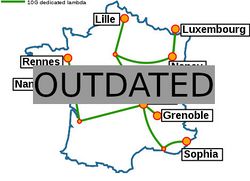Grid5000:Home: Difference between revisions
No edit summary |
No edit summary |
||
| Line 7: | Line 7: | ||
Key features: | Key features: | ||
* provides '''access to a large amount of resources''': 12000 cores, 800 compute-nodes grouped in homogeneous clusters, and featuring various technologies: GPU, SSD, NVMe, 10G Ethernet, Infiniband, | * provides '''access to a large amount of resources''': 12000 cores, 800 compute-nodes grouped in homogeneous clusters, and featuring various technologies: GPU, SSD, NVMe, 10G and 25G Ethernet, Infiniband, Omni-Path | ||
* '''highly reconfigurable and controllable''': researchers can experiment with a fully customized software stack thanks to bare-metal deployment features, and can isolate their experiment at the networking layer | * '''highly reconfigurable and controllable''': researchers can experiment with a fully customized software stack thanks to bare-metal deployment features, and can isolate their experiment at the networking layer | ||
* '''advanced monitoring and measurement features for traces collection of networking and power consumption''', providing a deep understanding of experiments | * '''advanced monitoring and measurement features for traces collection of networking and power consumption''', providing a deep understanding of experiments | ||
Revision as of 09:05, 9 November 2018
|
Grid'5000 is a large-scale and versatile testbed for experiment-driven research in all areas of computer science, with a focus on parallel and distributed computing including Cloud, HPC and Big Data. Key features:
Older documents:
|
Random pick of publications
Five random publications that benefited from Grid'5000 (at least 2927 overall):
- Théophile Bastian, Hugo Pompougnac, Alban Dutilleul, Fabrice Rastello. CesASMe and Staticdeps: static detection of memory-carried dependencies for code analyzers. INRIA. 2024, pp.1-12. hal-04477227 view on HAL pdf
- Rahma Hellali, Zaineb Chelly Dagdia, Karine Zeitouni. A Multi-Objective Multi-Agent Interactive Deep Reinforcement Learning Approach for Feature Selection. International conference on neural information processing, Dec 2024, Auckland (Nouvelle Zelande), New Zealand. pp.15. hal-04723314 view on HAL pdf
- Cédric Boscher, Nawel Benarba, Fatima Elhattab, Sara Bouchenak. Personalized Privacy-Preserving Federated Learning. Proceedings of the 25th International Middleware Conference, Dec 2024, Hong Kong, China. pp.454--466, 10.1145/3652892.3700785. hal-04770214 view on HAL pdf
- Rodrigo Wilkens, Rémi Cardon, Amalia Todirascu, Núria Gala. 3rd Workshop on Tools and Resources for People with REAding DIfficulties (READI 2024). Workshop at the Language Resources and Evaluation Conference (LREC 2024) jointly organized by the ELRA Language Resources Association and the International Committee on Computational Linguistics, 2024, 978-2-493814-34-0. hal-04580167 view on HAL pdf
- Mathieu Bacou. FaaSLoad : fine-grained performance and resource measurement for function-as-a-service. 2024. hal-04836444 view on HAL pdf
Latest news
Failed to load RSS feed from https://www.grid5000.fr/mediawiki/index.php?title=News&action=feed&feed=atom: Error parsing XML for RSS
Grid'5000 sites
Current funding
As from June 2008, Inria is the main contributor to Grid'5000 funding.
INRIA |
CNRS |
UniversitiesUniversité Grenoble Alpes, Grenoble INP |
Regional councilsAquitaine |


